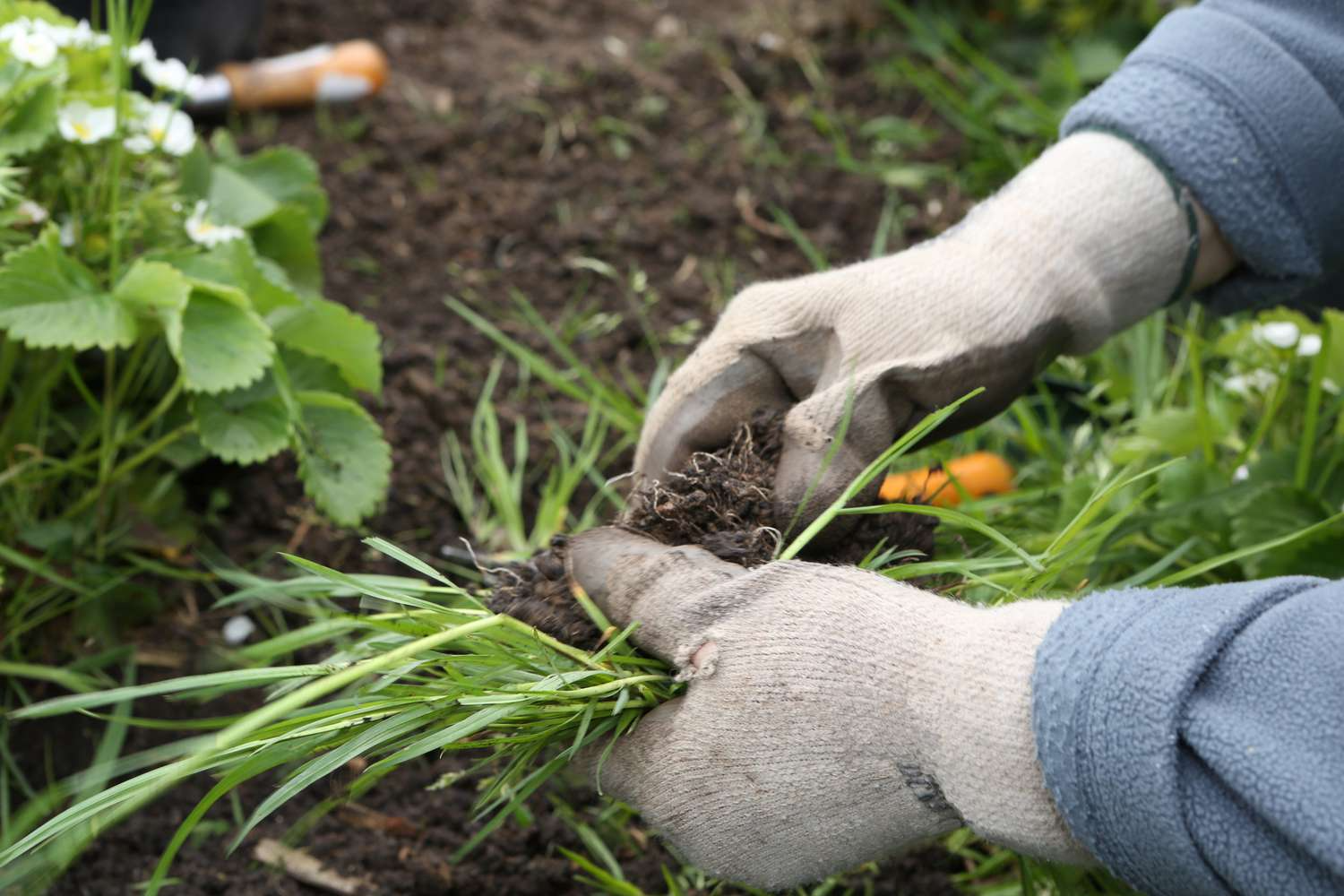How To Get Rid of Weeds in Lawn
Quick Links
Removing Weeds In Your Lawn
Whether you have installed a new turf or you have a 10-year-old turf, they will need care and maintenance to fully flourish.
But, did you know that all grass is not the same?
Depending on your region and the temperature difference, lawn grasses react differently and should be taken care of as per the need.
One of the most common problems that can be seen in almost all lawns is ” unwanted weed growth.”

It doesn’t matter whether you have warm-season grass or cold-season grass, your lawn will surely experience unwanted weeds.
Taking care of weeds is easy but if you leave them unattended they will soon take over your healthy grass.
Why Do Lawns Get Weeds In The First Place
There are three types of weeds that you’ll see in every lawn and landscape bed.
- Annual Weeds – These weeds grow in one specific season and die off at the end of their life cycle. Some common annual weeds include oxalis, groundsel, and chickweed.
- Biennial Weeds – These weeds can have a life cycle of up to two years. They germinate and produce leaves in their first year. In the second year, they produce seeds and multiply into more families restarting a life cycle all over again. Weeds such as clover, wild carrot, and prickly lettuce fall under biennial weeds.
- Perennial Weeds – Similar to biennial weeds, these weeds can also grow in multiple seasons. But, unlike the two weeds mentioned above, perennial weeds multiply and spread really fast. Dandelion broadleaf weeds, stemless thistle, and ground ivy are some of the fastest-growing perennial weeds.
All these weeds are considered to be opportunistic, they won’t miss a chance to grow if they find favourable conditions to germinate and multiply.
Weed seeds (especially broadleaf weeds) can also come from many other sources such as wind, bird guano, and honey bees.
The reason why dandelions can be seen in almost all lawn beds is that they can travel from one place to another with the help of wind.
Most Common Lawn Weeds
Weeds are part of nature! You will often see them growing here and there on or around your lawn.
Nobody can achieve perfect weed control unless they have unlimited time or money.
But if you’re able to identify the type of weeds, it gets easier to handle them. Here are some of the most commonly found weeds in both warm-season lawn grass.
- Dandelions – As we all know dandelions are beautiful yellow flowering plants but they can ruin the beauty of your lawn if not taken care of. Dandelions are perennial weeds and will come back every year. You can root out the plants when they are small but if the roots get stronger you’ll have to find other ways to tackle them.
- Crabgrass – Crabgrass germinates when the soil surface reaches 12 degrees. They can produce thousands and thousands of seeds if not treated on time. The best time to take care of crabgrass is during spring because this is the season they start to grow.
- Wintergrass – This grass can be a real pain if not treated. It seeds quickly when left unnoticed and can become a problem for years to come, reappearing each year in the cooler months.

- Nutsedge – These weeds are perennial weeds and can grow at any time of the year. They are also known for their stubbornness as they won’t leave your lawn that easily. They can grow really quickly, seemingly overnight. Even if you mow your lawn, it will grow back again using the energy they store inside its underground tubers.
- White Clover – White clover is another stubborn weed. Back in the old days, clover was a desirable part of turf seed mixes as it didn’t allow room for other lawn weeds to thrive. The only drawback was their patchy appearance on the lawn. They are also one of the fastest-growing and multiplying weeds.
Make sure you know the weeds you’re dealing with. If you can’t recognise the weed, a professional can guide you in the right direction to ensure you don’t harm your turf.
How To Get Rid Of Weeds
Hand Weeding
Uprooting weeds is by far the safest and the best way to remove weeds permanently. But keep in mind, as the plants get older, it will be more difficult to pull them out.
Killing weeds by the hand-pull method can be effective while they are young – before they flower and start to produce seeds.
Perennial weeds like dandelions broadleaf weeds have long taproots which makes them even harder to pull out as they get mature.
When pulling weeds gets harder, you can use weed diggers or scuffle hoes.

Some grassy weeds also have thorns and should be handled with care. Make sure to wear gloves or use scuffle hoes to uproot them.
Make sure to dig up the entire root to stop them from regrowing.
Use Herbicides To Kill Weeds (Chemical Measures)
Unlike hand weeding, removing existing weeds with the help of chemicals needs to be a step-by-step process. You can’t just buy any herbicides and start pouring them on the weeds.
Also, always keep the chemical method as a last resort as some herbicides are not only deadly weed killers but also deadly grass killers.
STEP 1 – IDENTIFY THE TYPE OF WEEDS
The first step is to identify the weeds. Take a snapshot with your smartphone and do a quick google search.
Understand the type of roots it has, how long can it get, and how fast the weed can produce seeds.
Understanding the type of weed will help you choose the right product for treatment.

STEP 2 – CHOOSE A TREATMENT
You can choose a treatment between natural herbicides and chemical products.
Natural treatment includes using boiling water, vinegar (the best natural weed killer), and other natural solutions.
Chemical herbicides usually fall into two categories. a)Pre-emergent which targets germinating seeds, b)Post-emergent which targets existing weeds.
Additionally, there are also selective herbicides (broadleaf herbicide for example) that target specific weeds.
STEP 3 – APPLY THE HERBICIDE
If you opt to use chemical herbicides make sure to follow the directions and use them with caution.
Non-selective herbicides can’t differentiate between turf and weeds so careful application is very important, otherwise, it will destroy whatever comes its way.
Also, make sure to check the status of the wind. Don’t apply herbicide if you’re experiencing windy conditions in your area as the product can blow onto other plants.
If your lawn is completely filled with weeds, it’s better to seek help from a professional.
Trying to handle the situations yourself could result in more harm than good.
5 Tips To Prevent Weed Growth
The best way to fight weeds is to prevent them from growing in the first place.
Here are a few tips for you to keep your lawn away from unwanted plants and grasses.
1. Select Good Quality Turf Grass – The first step to prevent weeds on your lawn is to select higher quality turf.
Less expensive turf may seem affordable but they often come with many unwanted weeds. Buy Turf Online turf comes with a guarantee to be free from weeds.

2. Dethatching Your Lawn -Dethatching is a method of removing excess thatch and loosening compacted soil.
It helps the turf to get more light, moisture, and essential nutrients.
Dethatching helps to keep the weeds out of your lawn by disrupting the weed roots and preventing them from growing.
3. Feed Regularly – As most weeds are stronger and store more energy than lawn grasses.
As soon as the lawn starts to stress out due to low fertiliser or water, weeds can start overpowering the turf.
By regularly fertilising your lawn, you can maintain its growth and it will better outcompete weeds.

4. Mow Higher – Mowing higher helps the grass to grow taller and thicker, this shade the soil from sunlight.
When the weed seeds don’t get the required sunlight due to shade, they die off after some time.
5. Water Deeply – Watering deeply doesn’t mean watering frequently. It means watering infrequently but deeply.
Watering deeply helps encourage your turf roots to grow deeper and better compete with weeds.
Say Goodbye To Weeds
Weeds are extremely adaptable to favourable environments. They can grow anywhere if it gets the slightest chance of survival. So, get ready to welcome them to your lawn all year round.
As you care for your lawn, make some effort to look around to find unwanted weeds and uproot them before they mature.
If you think the weeds are getting out of control, a good-quality herbicide should do the trick. To find the right herbicide for your needs, visit our online lawn care shop.

read more!
recent posts
Poolside Turf: Choosing and Maintaining Grass Around Pools
There’s nothing quite like stepping out of a swimming pool onto soft, lush grass. But when it comes to finding the best grass for around a pool, not all lawns are created equal. Chlorine pools, heavy foot traffic, and the unforgiving Australian sun can take a toll on...
Keeping Your Lawn Green and Healthy During the Summer Heat
Discover the best grass options for your lawn with our complete guide. Make informed choices for a lush, healthy yard. Read more to find your ideal grass!
Summer Lawn Weeds: Prevention and Management
Discover the best grass options for your lawn with our complete guide. Make informed choices for a lush, healthy yard. Read more to find your ideal grass!
The Ultimate Watering Guide for Summer Lawns
Discover the best grass options for your lawn with our complete guide. Make informed choices for a lush, healthy yard. Read more to find your ideal grass!

Our Turf
TifTuf Bermuda
Buy Turf Online © 2019 All Rights Reserved. | Proudly Designed and Developed by Sydney ICT





